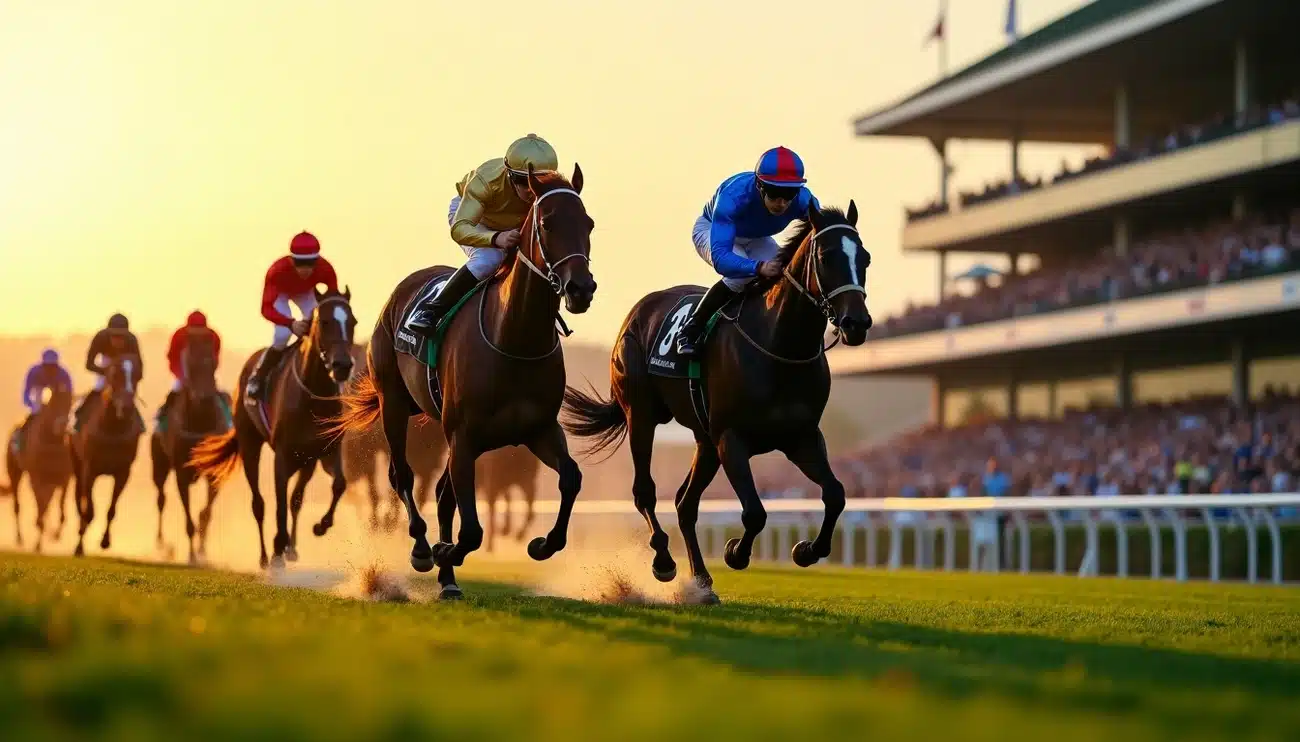Reverse Forecast Betting is explained in this betting guide. Here’s something that surprises most people – a £1 reverse forecast bet needs a £2 stake. Many new punters learn this the hard way during their first attempt.
Simple win-or-place bets remain popular, but reverse forecast betting gives you an edge that goes unnoticed. A reverse forecast bet lets you pick two participants to finish first and second. The best part? Their order doesn’t matter, which gives you better winning chances than a straight forecast.
Reverse forecast betting works best in races that have large fields. Your potential returns tend to be much better at the time you bet on races with more than 15 runners compared to races with fewer than 10 horses.
Let me share something interesting – a reverse forecast combines two straight forecast bets into one. This gives you flexibility with your selections’ finishing order. The strategy becomes valuable whenever you spot a high-odds horse that the market hasn’t properly valued.
Professional punters rarely share these betting secrets. This piece will reveal what they don’t tell you about reverse forecast betting. You’ll learn exactly how to use this strategy to get better results.
What is a Reverse Forecast Bet?
A reverse forecast is a unique betting strategy that lets you pick two participants to finish in the first two positions. You don’t need to specify their exact order. This approach gives you flexibility while still demanding accurate selections.
Definition and basic concept
The core idea of a reverse forecast bet focuses on wagering on two participants (usually in horse racing or greyhound racing) to grab the top two spots in any order. This type of bet belongs to the broader category of forecast bets. Your reverse forecast covers both possible combinations of your two picks.
A reverse forecast combines two elements into a single bet. Let’s say you pick Horse A and Horse B. Your bet wins in two cases:
- Horse A takes first place, and Horse B comes second
- Horse B takes first place, and Horse A comes second
Your bet succeeds only if both horses finish in the top two spots. The bet fails if either horse finishes third or lower.
How is it different from a straight forecast?
The biggest difference between a reverse forecast and a straight forecast comes down to finish order requirements. A straight forecast needs you to predict the exact order of first and second place. Your bet loses if you pick Hamilton to win and Vettel to place second, but Vettel wins instead with Hamilton in second.
A reverse forecast offers more flexibility by including both possible finish orders. This makes winning easier than with a straight forecast, though the payouts adjust accordingly.
The stake structure marks another key difference. A reverse forecast needs twice the stake of a straight forecast. This happens because you’re placing two bets at once:
- Selection A wins, Selection B places second
- Selection B wins, Selection A places second
A £5 reverse forecast costs £10 total. This doubled stake reflects your better chances of winning.
Reverse forecast meaning in simple terms
Picture a reverse forecast as insurance for your forecast bet. Rather than locking in a specific order, you’re saying: “These two will finish first and second – I just don’t know which way around.”
This betting style works great in several situations. It helps when you can’t decide between two strong contenders, letting you back both possible outcomes. It also protects you when you know your picks will finish top two but aren’t sure about their exact order.
Reverse forecasts become even more valuable in races with many participants. The challenge of predicting exact order increases with field size, making a reverse forecast’s flexibility worth more.
A reverse forecast combines two straight forecasts into one bet. It removes the order requirement but doubles your stake. Many strategic bettors love this balanced approach between precise predictions and winning chances.
How Does a Reverse Forecast Work?
The mechanics of a reverse forecast bet go beyond its simple definition. Let me show you how this betting option works in real life. It has a unique structure that gives bettors both opportunities and challenges.
Understanding the two-part bet structure
A reverse forecast works as two separate bets in one convenient wager. You’re creating two different forecast bets when you place this type of bet:
- Selection A to finish first and Selection B to finish second
- Selection B to finish first and Selection A to finish second
This dual-bet structure makes reverse forecasts more flexible than straight forecasts. You’ll win if either scenario plays out.
Here’s a real example that makes it clearer: If you pick horses 5 and 8 in a reverse forecast, you win if horse 5 wins and horse 8 comes second OR if horse 8 wins and horse 5 comes second. This flexibility is great when you know your top two finishers but aren’t sure about their exact order.
Why is the stake doubled?
The doubled stake happens because of the two-part structure. A reverse forecast includes two separate forecast bets, and the total stake reflects this.
Your stake gets doubled right away. A £5 reverse forecast costs £10 in total. The same goes for a £20 reverse forecast – you’re putting £10 on each possible combination, bringing your total stake to £20.
You need this doubled stake because you’re covering both possible orders. You’re paying extra to avoid specifying the exact finishing order. The flexibility costs twice as much as a straight forecast, but it’s straightforward.
Reverse forecast calculator and payout logic
Reverse forecast payouts follow different rules from standard betting odds. Bookmakers use the Computer Straight Forecast (CSF) algorithm to figure out reverse forecast payouts.
The CSF method shows payouts as a dividend, which you get back from a £1 bet. A straight forecast might have an £8.21 dividend, meaning you’d get £8.21 for every £1 you bet. That’s the same as 7.21/1 in fractional odds.
The reverse forecast doesn’t have its dividend because only one combination wins. The payout depends on which combination comes through. You won’t know your exact winnings until after the race.
The CSF formula looks at:
- The number of horses/participants in the race
- The odds of all participants
- The odds of the first and second-place finishers
Betting websites and apps provide reverse forecast calculators to help you estimate potential payouts. These tools use your stake amount and selection odds. The final payout comes after the race ends, when the forecast terms are announced.
If one of your selections doesn’t run, the reverse forecast becomes a single bet at the Starting Price (SP) of the other selection. This keeps your bet alive even if one selection drops out.
This approach combines two forecast bets, doubled stakes, and special payout calculations. It’s a unique way to profit from race predictions without getting the exact order right.
When to Use a Reverse Forecast
Your success rate with reverse forecast bets depends on picking the right moment to place them. Smart bettors who make consistent profits know exactly when to use this versatile betting option.
Ideal race conditions and field size
The number of runners in a race affects your potential returns from reverse forecast bets. Races with more than 15 runners pay out better than those with fewer than 10 horses. This makes sense because picking the top two finishers becomes harder as more horses join the race.
Reverse forecasts work great in handicap races. Many professional bettors target these events because they believe they can make better handicapping decisions than the official committee. The perfect setup happens when you’ve done your homework on several horses and two from your “virtual stable” end up in the same race.
On top of that, flat racing events with strong draw bias create excellent conditions for reverse forecasts. Some racecourses have a faster side of the track that gives certain starting positions a natural edge. This bias can turn a 10-runner field into just 3-4 real contenders, which makes your reverse forecast chances much better.
When you can’t split the top two
Reverse forecasts shine in races where you see two clear standouts but can’t decide which one is better. This bet type covers both possible finishing orders instead of risking everything on one horse.
To cite an instance, you might see two horses leading the market—one at 6/5 and another at 7/4—with all others at much longer odds (8/1+). A reverse forecast protects you if you’re not sure which favourite will come out on top. Your bet wins either way as long as these two horses finish first and second.
Avoiding short-priced favourites
Market conditions sometimes create value opportunities when favourites look shaky. If you think a heavily-backed favourite might struggle based on the conditions or other factors, you could try a reverse forecast with two longer-odds picks.
This strategy works best when the market undervalues certain horses. Odds sometimes fail to show a higher-priced horse’s real chances accurately. Let’s say the third and fourth favourites seem overpriced, but the fifth or sixth choice looks like genuine value. A reverse forecast combining these overlooked horses could pay out really well.
Reverse Forecast vs Other Bet Types
Reverse forecasts open up a world of related betting options. Smart punters can gain more strategic flexibility by learning about the differences between these formats.
Straight forecast vs reverse forecast
The main difference between these bet types comes down to order requirements. A straight forecast needs your selections to finish exactly as predicted—first and second in the specified order. A reverse forecast gives you more flexibility by covering both possible arrangements of your two selections.
This extra flexibility costs more—you’ll pay double the stake of a straight forecast [link_1] for a reverse forecast. A £1 reverse forecast costs £2 because you place two separate bets. The higher cost buys you protection against getting the finishing order wrong.
The payouts work differently, too. Both use the Computer Straight Forecast (CSF) formula, but straight forecasts usually pay more because they’re harder to win.
Combination forecast explained
A combination forecast might be your best option when you can’t pick just two competitors. You can choose three or more participants, and any two need to finish first and second in any order.
Your stake grows based on your selections:
- Three selections = 6 bets
- Four selections = 12 bets
- Five selections = 20 bets
- Six selections = 30 bets
A combination forecast covers every possible straight forecast combination from your chosen selections. This bet type works well when you spot several strong contenders but aren’t sure which two will come out on top.
Tricast and reverse tricast differences
Tricasts take forecast betting one step further—you predict the first, second, and third finishers in exact order. These bets can pay much more than forecasts because they’re harder to get right.
Similar to reverse forecasts, reverse tricasts (also called combination tricasts) let you cover multiple finishing arrangements for three selections. You’ll need six bets for a reverse tricast with three selections—one for each possible arrangement.
Forecasts need only two correct picks, but tricasts require accuracy across three positions. This makes them much tougher to win, but potentially more rewarding.
Common Pitfalls and How to Avoid Them
Even the best calculated reverse forecast bets can run into unexpected problems. You can save money and avoid frustration by knowing the potential pitfalls before placing your bets.
Non-runners and how they affect your bet
Bookmaker policies vary a lot when a selection in your reverse forecast doesn’t race. Some bookmakers convert your bet into a single bet on the remaining selection at Starting Price (SP). Your reverse forecast becomes a single bet on greyhound 5 to win if greyhound 8 doesn’t run.
Many bookmakers simply cancel the whole bet. Sky Bet clearly states that “Forecast Bets with a non-runner will be made void”. Paddy Power follows similar rules.
The rules change when both selections pull out. All bookmakers void the bet and give you back your stake in these cases.
Dead heats and payout adjustments
Dead heats happen when two participants finish in an exact tie. These situations affect your reverse forecast returns through proportional reduction calculations.
Bookmakers divide your stake by the number of participants in the dead heat. They multiply this reduced stake by the original odds. You only get half your stake counted toward the winning combination in a two-way dead heat.
Some bookmakers switch to standard industry dividends instead of their fixed-odds payouts during dead heats.
Bookmaker rules you should know
You should know several more bookmaker-specific policies beyond non-runners and dead heats:
- Rule 4 deductions might apply after withdrawals, which reduces your potential returns based on the withdrawn selection’s odds
- Your reverse forecast loses automatically if fewer than two horses finish the race
- Multiple Rule 4 deductions can hit a single race when going changes lead to several withdrawals
Check your chosen bookmaker’s specific terms before placing reverse forecast bets. Each operator has different policies, and knowing them helps avoid surprises when they settle your bets.
Reverse Forecast Betting – The Conclusion
Reverse forecast betting gives punters a strategic edge when they look beyond simple win-or-place bets. The flexibility to cover both potential finishing orders creates a safety net. This helps you, especially when you have two strong contenders but aren’t sure about their exact positions. This betting approach works best in races with larger fields where returns are bigger than those in smaller competitions.
New bettors should understand the doubled stake requirement. Many think a £1 reverse forecast costs exactly that amount, but later find they’ve placed a £2 bet. You’re actually funding two separate forecast bets at the same time—each covers a different finishing order possibility.
Smart field selection plays a key role in getting value from reverse forecasts. Handicap races and events with draw bias create ideal conditions for this betting strategy. Knowing how to spot races where reverse forecasts offer real value sets regular winners apart from casual bettors.
Bookmaker rules about non-runners, dead heats, and potential deductions can protect your betting experience. These policies differ a lot between operators and can affect your potential returns. So, take time to check these terms before placing your bet to avoid surprises during settlement.
Reverse forecasts need more precision than simple win bets, but nowhere near as much as tricasts or straight forecasts. This middle-ground approach works great when you have two strong contenders. Next time you see a race with two standouts but can’t pick between them, try a reverse forecast as your betting solution.
Reverse Forecast Betting – Your FAQs
Q1. How does a reverse forecast bet work? A reverse forecast bet involves selecting two participants to finish first and second in any order. It’s essentially two separate bets combined into one, covering both possible finishing orders of your selections. This type of bet requires double the stake of a straight forecast, as you’re placing two bets simultaneously.
Q2. When is the best time to use a reverse forecast bet? Reverse forecasts are particularly effective in races with larger fields (more than 15 runners) and in handicap races. They’re also useful when you can’t decide between two strong contenders or when you believe the market has undervalued certain participants. Avoiding short-priced favourites can sometimes create value opportunities with this bet type.
Q3. How does a reverse forecast differ from other bet types? Unlike a straight forecast, a reverse forecast doesn’t require you to predict the exact finishing order. It offers more flexibility but at double the stake. Combination forecasts allow for more than two selections, while tricasts involve predicting the first three finishers. Reverse forecasts strike a balance between precision and winning probability.
Q4. What happens to a reverse forecast bet if there’s a non-runner? If one of your selections becomes a non-runner, the bet is typically treated as a single bet on the remaining selection at Starting Price (SP). However, policies can vary between bookmakers, with some voiding the entire bet. If both selections withdraw, the bet is usually voided and your stake returned.
Q5. How are reverse forecast payouts calculated? Payouts for reverse forecasts are typically calculated using the Computer Straight Forecast (CSF) algorithm. The final payout is based on whichever combination materialises and is only known after the race concludes. Factors considered include the number of participants, odds of all runners, and specifically the odds of the first and second-place finishers.



